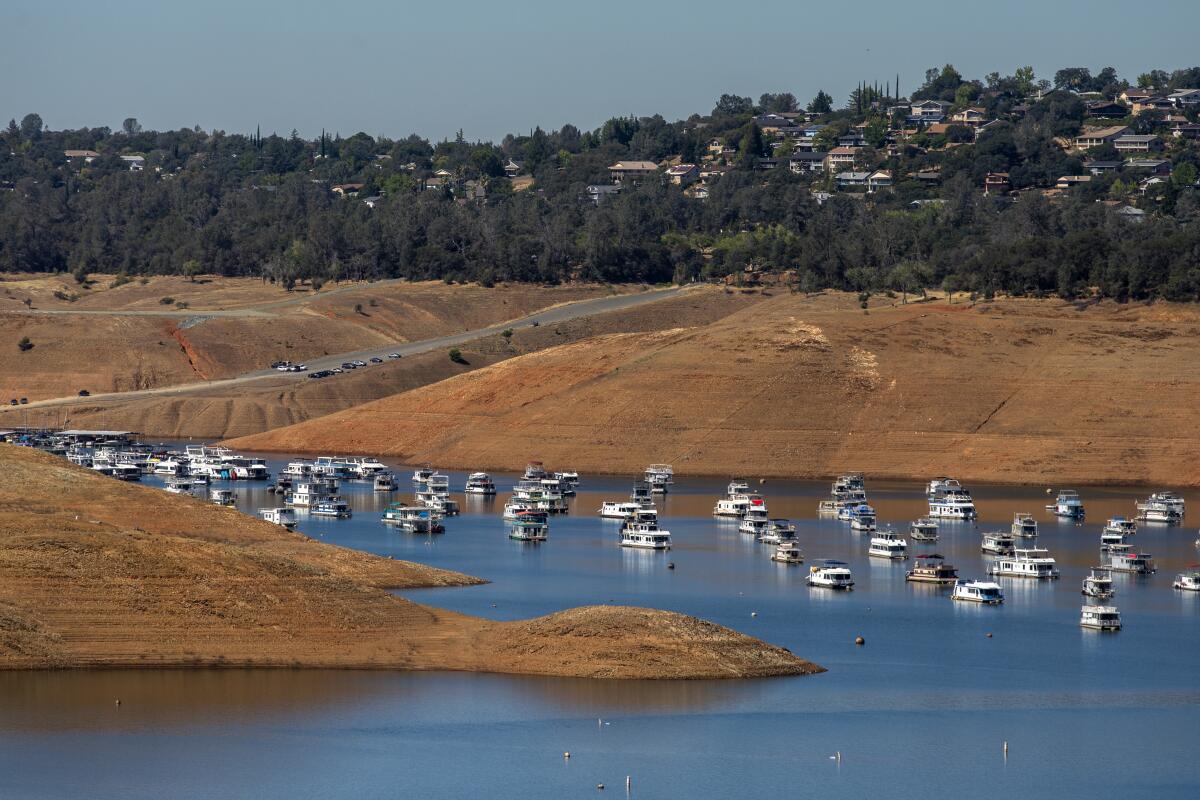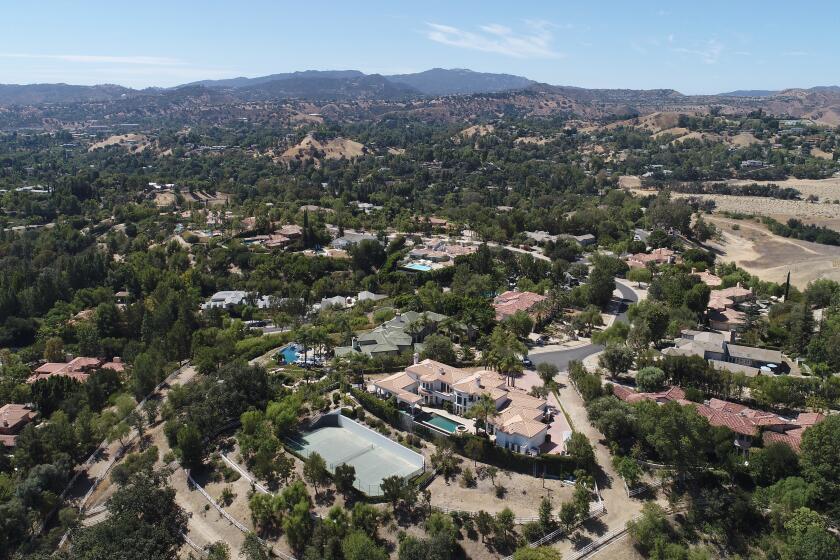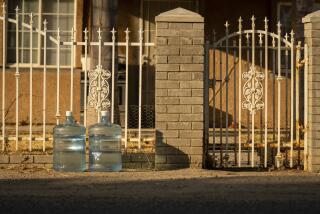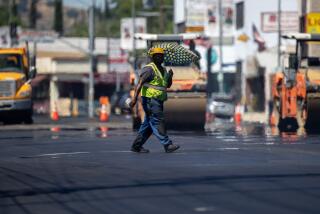Most Californians view state’s water shortage as extremely serious, poll finds

- Share via
Most Californians agree the state’s drought situation is very serious, but only a minority of voters say they and their families have been significantly affected by the current water shortage, according to a new poll.
The survey of more than 9,000 voters statewide found that 71% said the state’s water shortage is “extremely serious,” while 23% described it as somewhat serious.
Far fewer of those voters indicated they are directly feeling the effects of the drought, according to the poll by the UC Berkeley Institute of Governmental Studies, which was co-sponsored by the Los Angeles Times. Just 9% said they and their families have been affected “a great deal” by the current water shortage, and 32% said they’ve been affected somewhat, while 57% said they have been affected “only a little” or not at all.
That’s a notable change from 2015, during California’s last major drought, when a similar poll found that 58% said they were affected at least somewhat by the water shortage at that time, and that 76% described the shortage as extremely serious.
“What’s striking to me is that it’s not really directly affecting as many voters as you might think,” said Mark DiCamillo, director of the Berkeley IGS poll. During the current drought, he said, the water shortage “really hasn’t been as broadly felt by voters, at least not up to this point.”
The survey results didn’t directly address why that might be. But months before that October 2015 poll, at the height of the 2012-2016 drought, then-Gov. Jerry Brown ordered cities and towns to cut water use by 25% under mandatory statewide restrictions.
Gov. Gavin Newsom has taken a different approach, calling for Californians to voluntarily reduce water use by 15% while giving local water suppliers greater leeway in adopting conservation measures.
In large portions of Los Angeles County, there are mandatory restrictions limiting outdoor watering. Many of the L.A. County voters who participated in the survey said they’re not having trouble complying, but a large majority also said they’re already doing all they can to conserve.
Asked how easy or difficult it has been to follow water restrictions, 44% of L.A. County respondents said complying has been easy, 13% said it’s been difficult, and 43% said they don’t know or have no opinion. Renters were more likely to have no opinion. Among homeowners, 55% said complying with water restrictions has been easy. About 1-in-5 homeowners said compliance has been difficult, but only 3% said it has been “very difficult.”
The celebs were among 2,000 Las Virgenes Municipal Water District customers who recently received ‘notices of exceedence’ for water usage.
The poll found some differences among regions and demographic groups, with older voters, homeowners, Latino voters who primarily speak Spanish, and voters in the Central Valley somewhat more likely than other groups to say they’ve been affected by the water shortage.
The share of voters who said they have been at least somewhat affected ranged from a low of 27% in Orange County to a high of 52% in the San Joaquin Valley.
Farmers in the San Joaquin Valley are coping with major cuts in water supplies and have been drawing on groundwater while leaving large portions of farmland dry and unplanted. With groundwater levels dropping, hundreds of household wells have dried up in the region over the past year. The state has received reports of 966 dry wells throughout California so far this year, a 72% increase over the same period last year. Many of the wells that have run dry are in farming areas, mostly affecting low-income residents.
Eighteen percent of those who live in the San Joaquin Valley said they have been affected “a great deal” by water shortages, more than any other region of the state.
To the north, in the Sacramento Valley, 42% said they have been affected somewhat or a great deal. That parallels similar percentages in many other parts of the state. In Los Angeles County, 42% said they have been affected, with 9% saying they have been affected a great deal.
The results indicate that people in farming areas have been feeling the effects of shortages more than those in other parts of the state, said Faith Kearns, a scientist with the California Institute for Water Resources.
“My sense is probably that in urban areas, people are largely buffered, even though in some regions, people have been asked to reduce their landscaping water and things like that,” Kearns said. “But I think for most people, when they go to turn on the tap, the water still comes out. And so they aren’t as deeply affected by it, if you’re not in an area where you’re seeing the effects of water shortage every day.”
The poll found that Californians have some conflicting and unsettled opinions about agricultural water use. Surveyed voters statewide were split on whether they think farmers are “doing their part to reduce their water use to help the state get through the drought.” Twenty-nine percent said yes, and 28% said no, while 43% said they don’t know.
Voters also split when asked whether the state’s residential users are doing their part, with 32% saying they are, 42% saying they are not, and 26% saying they don’t know.
“Business and commercial water users” got a more negative grade, with 48% saying they aren’t doing their part, compared with 13% who said they are and 39% who said they don’t know.
The “no opinion” camp was larger (45%) when people were asked whether they believe California’s drought rules and water restrictions are “being implemented fairly” for those three types of water users.
Kearns said she thought it was striking that many people had no opinion about whether agricultural water users are doing enough to reduce water use.
According to state data, agriculture uses about 80% of the water that is diverted and pumped in an average year in California, producing crops including hay, almonds, pistachios, walnuts, grapes, rice and many other fruit and vegetables.
Those survey responses, Kearns said, reflect “where water education and conservation campaigns have been focused, which is on individuals at the household level.” And she said the results point to a need to further raise awareness about how water is used in California.
“The fact that so many people don’t know what they think about ag water use, and to a lesser degree commercial water use, means that there is some work to do in terms of increasing understanding about more systemic water use issues,” Kearns said.
Californians strongly agreed, in all regions and across all demographic groups, that the state’s current water shortage is extremely serious. Those with the highest levels of concern included Democrats, voters 65 and older, and those living in the Bay Area and on the Central Coast.
California’s extreme drought, now in its third year, is being exacerbated by rising temperatures with global warming. A new water-supply plan released this month by Gov. Gavin Newsom laid out a series of actions aimed at preparing for an estimated 10% decrease in California’s water supply by 2040 as climate change continues to bring hotter, drier conditions.
Many Californians seem to agree it’s time to get rid of thirsty grass and switch to drought-tolerant landscaping. Seventy-two percent said they think it is important for homeowners to make permanent landscaping changes by removing lawns and putting in plants that don’t require much water.
On this and other questions related to water policies, there were differences between Democrats and Republicans, and between voters who describe themselves as liberals and conservatives. When asked about removing lawns, 85% of Democrats said they think such landscaping changes are important, while only 49% of Republicans agreed. Republicans were also more likely to say California’s water restrictions are being implemented unfairly.
DiCamillo said he thinks these differences mainly reflect how conservatives and Republicans “are less apt to support these kinds of restrictions on what you’re able to do with your own life and your own property.”
The partisan gap was smaller than on many other issues, however, and a majority across the political spectrum agreed on the seriousness of the water situation.
“It’s pretty hard to find things where a majority of people agree these days,” Kearns said. “People obviously really care about these water issues.”
In another question, voters in L.A. County were asked: “Do you believe that you and your household are already doing all you can to conserve water?” Seventy-two percent said yes, while 20% said no and 8% said they didn’t know.
“If you feel like you’ve done all you can in terms of changing your landscaping and taking shorter showers and doing all of that kind of stuff, but there’s still this water shortage, then where are you left?” Kearns said. “To me, it gets into more of these large-scale issues like agricultural and commercial water use, and the sense that people feel like they don’t actually know whether those sectors are taking enough action.”
“It speaks to this idea that maybe we need a little bit more of a systemic look at water use in California on a broad scale, and that residents are probably actually pretty ready to have a deeper understanding, beyond their own households, of water in the state,” she said.
The poll was conducted online in English and Spanish from Aug. 9-15 and surveyed a random sample of 9,254 California registered voters. It has an estimated error margin of 2 percentage points in the statewide results, and 2.5 percentage points in the results for L.A. County.
Times Senior Editor David Lauter contributed to this report.








